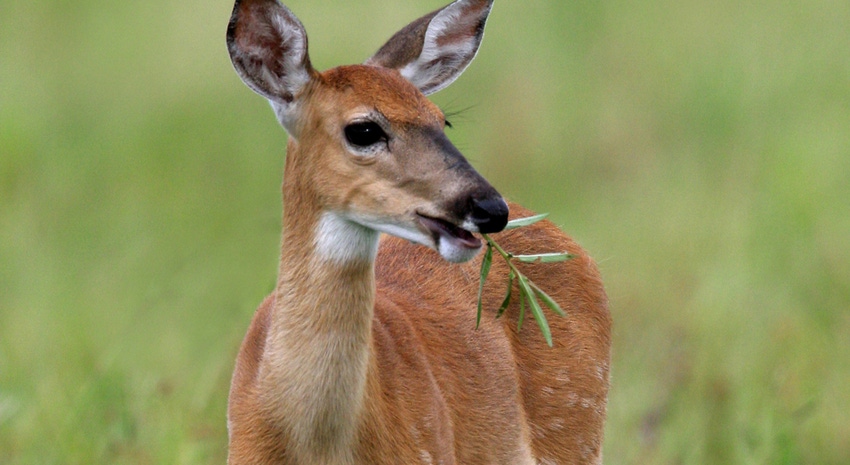CWD resistance heritable among white-tailed deer
Response to chronic wasting disease may be predicted with genomic tool, meaning selective breeding programs can be developed for deer.
July 21, 2020

Dr. Christopher Seabury, an associate professor of genomics at the Texas A&M College of Veterinary Medicine & Biomedical Sciences (CVM), has confirmed that certain aspects of the white-tailed deer’s response to chronic wasting disease (CWD) are moderately to highly heritable — or passed from parent to offspring — and can be predicted using a custom genomic tool designed by Seabury and his team.
This custom tool, a novel array designed by Seabury, can be used to predict a white-tailed deer’s responses to CWD exposure with high accuracy and specificity, meaning that the array is likely to become widely deployed for use in a genetic evaluation program aimed at reducing the prevalence of CWD, according to an announcement from CVM.
Such a program would allow deer farmers, wildlife managers and regulatory agencies to selectively breed the least-susceptible deer, thereby building healthier, CWD-resistant deer populations. This tool and program could support herd health of both farmed and free-ranging deer populations, although the initial application of this technology is currently focusing on U.S. farmed white-tailed deer, CVM said.
CWD is a fatal syndrome that causes weight loss, ataxia (as part of a degenerative disease of the nervous system), listlessness and other neurological symptoms in both farmed and free-ranging U.S. mule deer, elk, moose and white-tailed deer populations.
CWD is recognized as a prion disease, meaning that an infectious misfolded protein is instrumental for behavioral changes, emaciation and progressive neurological disease that lead to death, CVM explained. Another relevant prion disease known as scrapie affects both sheep and goats and was first recognized in sheep as early as the 18th century.
Importantly, the prevalence of scrapie has been reduced by approximately 85% through a federal eradication program administered by the U.S. Department of Agriculture's Animal & Plant Health Inspection Service, CVM said.
CWD is currently present in at least 26 U.S. states, multiple Canadian provinces and several areas in Eurasia, but its geographic distribution is expanding despite the implementation of surveillance programs that aim to contain and depopulate CWD-positive herds.
Some naturally occurring genetic variation within the PRNP gene — which encodes the normal cellular prion protein — previously has been associated with enhanced risk for CWD, CVM said. However, this study clearly demonstrates that while some genetic variation within the PRNP gene has large effects on risk for CWD, selective breeding based upon PRNP information alone is insufficient to facilitate a rapid reduction in the overall prevalence of CWD in farmed U.S. white-tailed deer.
Seabury’s research, published in G3: Genes, Genomes, Genetics, used molecular genetic techniques and machine learning to analyze DNA samples from deer with and without CWD.
He and his team confirmed the G96S genetic variant of the PRNP gene as having large effects on risk while also demonstrating for the first time that genetic variation in other genes collectively explains more differential susceptibility and variation in disease progression than PRNP alone, thereby necessitating a whole-genome approach to selective breeding.
The novel test designed and validated by Seabury in this study involves a custom Affymetrix Axiom single nucleotide polymorphism (SNP) array -- which is used to collect genome-wide DNA profiles from white-tailed deer -- for both association mapping and machine learning, CVM said in its announcement.
“One of the most important things from this initial study is the mean genomic prediction accuracy, which hovers around 81%,” Seabury said. “This means that we can predict with about 81% accuracy the phenotype of a tested animal and that we can accurately estimate the genetic merit of each animal, as it relates to CWD, by producing something called genomically estimated breeding values.”
This novel strategy for producing genomic predictions for risk of CWD in white-tailed deer could be used to mitigate CWD risk in both farmed and free-ranging deer populations.
“White-tailed deer are very adaptable and prolific, often reappearing in free-ranging areas where depopulation or herd reduction was attempted to control CWD," Seabury said. "Additionally, in regions where indigenous anthrax occurs and has caused wide-spread dead loss among white-tailed deer, managers have often reintroduced white-tailed deer by translocation. Wouldn’t you like to be able to select deer for replacement that you felt would reduce the population’s overall risk for CWD?”
Seabury’s next goal includes making the test an affordable and reliable tool deer farmers and wildlife agencies can use to ensure healthier populations of white-tailed deer.
“I want to achieve a final array designed to be so cheap that it can be widely used and implemented,” Seabury said. “I’m going to strive to redesign the array to maximize the prediction accuracy but also minimize the costs.”
You May Also Like


.png?width=300&auto=webp&quality=80&disable=upscale)
